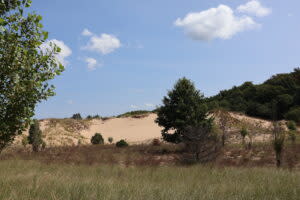Parabolic dunes near Oval Beach in Saugatuck Michigan. Taken Aug. 21, 2024. | Kyle Davidson
With sun shining on the grassy dunes behind them at Oval Beach in Saugatuck, state Reps. Rachel Hood (D-Grand Rapids) and Joey Andrews (D-St. Joseph) last week discussed two bills in the works to protect critical dunes like those behind them.
Michigan is home to 74,000 acres of critical dune areas along 265 miles of coastline, according to the Department of Environment, Great Lakes and Energy (EGLE). These areas support many rare plants, animals and natural communities, including a number of threatened and endangered species.
While these areas are now protected under the Natural Resources and Environmental Protection Act, they previously faced threats from sand mining and development.
David Swan, board president of the Saugatuck Dunes Coastal alliance warned that these threats persist and emphasized that Hill and Andrews’ bills had more to do with the economy than the environment.
“To protect and stimulate our economy, we must protect our geography, and in Saugatuck, that means protecting the dunes,” Swan said.
Saugatuck Mayor Lauren Stanton said nearly 2 million visitors come to Saugatuck annually, and have a $255 million impact on the economy, with the Saugatuck Dunes and beaches acting as the primary draw for visitors, alongside the undeveloped riverfront winding through the dunes.
Tourism is Michigan’s third largest industry, Hood said, with the industry accounting for $50 billion in economic activity, over 320,000 jobs.
Hood also noted the ever changing nature of dunes and the importance of planning appropriately along Michigan’s shorelines.
“Water levels, be they high or low, have a huge impact on public safety, infrastructure and our communities. We’ve learned that natural solutions are the best solutions when it comes to preventing buildings from collapsing, infrastructure from eroding, but the first and most dependable solution is to make wise and informed, science based decisions about where, how and what to build in the first place,” Hood said.
“We’ve coexisted with nature on our shorelines for decades, and we can once again with these bills,” Hood said.
Andrews’ bill aims to modernize EGLE’s rules around sand mining and clarifying the intent around previous sand dune mining laws, noting that these laws are focused on large mines for industrial or commercial reasons, rather than mid and small scale projects for homes, ponds, lakes, recreational and aesthetic purposes and other similar site developments.
The bill also requires a reclamation plan as part of the requirements for sand dune mining permits, including topsoil conservation when possible and preservation and reclamation requirements to protect the biological integrity and fertility of the soil, Andrews said. It also updates permit amendments, expands public communication based on the permit changes, and implements a fee for surveillance, monitoring, administration and enforcement of the permit.

Parabolic Dunes near Oval Beach in Saugatuck Michigan, taken Aug. 21, 2024. | Kyle Davidson

David Swan, board president of the Saugatuck Dunes Coastal Alliance discusses the importance of preserving Michigan’s critical dune areas during a Aug. 21, 2024 press conference in Saugatuck. | Kyle Davidson

State Rep. Joey Andrews (D-St. Joseph) listens in as David Swan, board president of the Saugatuck Dunes Coastal Alliance discusses the importance of preserving Michigan’s critical dune areas during a Aug. 21, 2024 press conference in Saugatuck. | Kyle Davidson

State Rep. Rachel Hood (D- Grand Rapids) listens as David Swan, board president of the Saugatuck Dunes Coastal Alliance discusses the importance of preserving Michigan’s critical dune areas during a Aug. 21, 2024 press conference in Saugatuck. | Kyle Davidson

State Reps. Rachel Hood (D-Grand Rapids) and Joey Andrews (D-St. Joseph) joined community members and environmental advocates on Oval Beach in Saugatuck on Aug. 21, 2024 to discuss their effort to protect Michigan’s critical dunes from harmful development. | Kyle Davidson

David Swan, board president of the Saugatuck Dunes Coastal Alliance takes questions alongside state Reps. Rachel Hood (D-Grand Rapids) and Joey Andrews (D-St. Joseph) at an Aug. 21, 2024 press conference at Oval Beach. | Kyle Davidson

On Oval Beach in Saugatuck on Aug. 21, 2024, State Reps. Rachel Hood (D-Grand Rapids) and Joey Andrews (D-St. Joseph) discuss in-progress legislation to protect Michigan dunes from harmful development. | Kyle Davidson

Saugatuck Mayor Lauren Stanton discusses the importance of dunes to the community at Oval Beach on Aug. 21, 2024 | Kyle Davidson

Saugatuck Harbor Natural Area, Aug. 21, 2024. | Kyle Davidson

Oval Beach in Saugatuck, Michigan, Aug. 21, 2024. | Kyle Davidson

Trails leading out from Oval Beach in Saugatuck, Michigan. Taken Aug. 21, 2024 | Kyle Davidson

Saugatuck Harbor Natural Area, Aug. 21, 2024. | Kyle Davidson

The Oxbow Lagoon in Saugatuck Harbor Natural Area, Aug. 21, 2024. | Kyle Davidson

Parabolic dunes near Oval Beach in Saugatuck Michigan. Taken Aug. 21, 2024. | Kyle Davidson

Oval Beach in Saugatuck, Michigan, Aug. 21, 2024. | Kyle Davidson
Hood’s bill will also update and reverse previous pieces of sand dunes legislation to clarify the roles state and local governments play in permitting development in critical dune areas. It also invests in mapping out critical dune areas, with Hood noting she had already secured funds for this effort in her role as chair of the House Appropriations Subcommittee for the Department of Environment, Great Lakes and Energy.
It would also allow for more flexibility in state funding for the Critical Dune Atlas, which maps known critical dune areas in the state.
“We will establish appropriate environmental regulatory practices to protect Michigan’s unique freshwater dune ecosystem. The bill will use traditional ecological regulatory practices to restore the minimum protections and guidelines under which communities can permit development in critical dunes with proven and tested practices that protect public safety and allow fragile ecosystems to flourish,” Hood said.
The bill also clarifies restoration requirements, and enhances the state’s ability to require feasible and prudent alternatives to balance development with historical ecological and community constraints and visions, Hood said.
Hood noted that the bill would continue to allow local governments to exercise additional controls through their own planning and development practices. It also clarifies improved due process practices to allow for exceptions and appeals in the permitting process, and updates permit costs.
“Michigan’s critical sand dunes protection laws stood in the courts for 36 years until 2012 when changes to the law that favored easy development over public safety and smart ecology minded development were passed,” Hood said. “Further the 2012 rollbacks eliminated transparency public input and aligned with a spending plan that starved the State System of protections put in place to ensure responsible use of these highly sensitive ecosystems and land.”
Andrews emphasized that the effort is intended to be forward looking, noting how homeowners along the coastline had been negatively impacted by erosion and high water levels.
As wind, waves, water levels and other factors continue to wear away at Michigan’s coastal shores, EGLE has identified high risk erosion areas, where the shoreline is expected to erode at least one foot per year for a minimum of 15 years, creating threats to homes and infrastructure.
“We see this as part of a holistic approach to preventing future problems when it comes to development along the coastline. It’s not about any specific development, or any specific developer or anything like that,” Andrews said. “There’s going to be more coming over time as we’re trying to figure out how we coexist with Lake Michigan and the other Great Lakes, and this is part of a bigger picture.”
While some rushed to protect their properties by hardening the shoreline with seawalls or rubble, EGLE has warned this can cause other issues such as increased water turbidity, damage to adjacent properties, decreased water quality and the proliferation of aquatic invasive species.
Hood told reporters her bill would make it more difficult to permit shoreline hardening efforts, requiring feasible alternatives for softer approaches like sandbagging, as Andrews noted his office is working on legislation to clarify sandbags as a better alternative.
While the bills are still in draft form, Hood said she welcomes conversation from stakeholders, noting she had been working on the legislation for six years.
“I am hopeful that we will be able to submit in September, a solid draft that represents the voices of all the stakeholders in this conversation, up and down our shorelines and I’m hopeful that we can secure a legislative path forward together over the coming months,” Hood said.
SUBSCRIBE: GET THE MORNING HEADLINES DELIVERED TO YOUR INBOX
EMEA Tribune is not involved in this news article, it is taken from our partners and or from the News Agencies. Copyright and Credit go to the News Agencies, email news@emeatribune.com Follow our WhatsApp verified Channel





